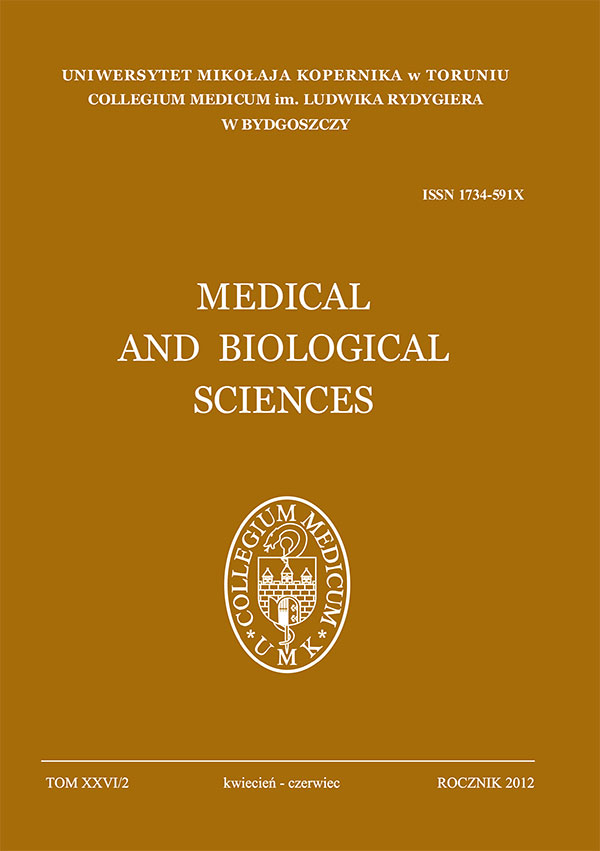Detailed analysis of a 240-second cycle ergometric test in middle-distance runners aged 16-19
DOI:
https://doi.org/10.12775/4080Keywords
training, exercise stress tests, middle-distance runningAbstract
Introduction. Middle-distance runs are endurance events that include the distances from 600 m up to 1609 m. The objective of the research is to determine work capabilities in acid and lactic conditions, measured by means of a 240-second test in young junior (16-17 years of age) and junior (18-19 years of age) runners at middle distances and to compare maximum lactate concentrations and maximum heart rate after 60-second and 240-second tests of the subjects.
Methods. The research included 20 competitors aged 16-17 and 12 competitors aged 18-19. During the test period all subjects were training in the Kujawsko-Pomorskie province sport clubs. In order to determine work capabilities in acid-lactic conditions, a 240-second cycle ergometric laboratory test was applied. The obtained results were worked out using basic descriptive statistics: arithmetic average (M), standard deviation (± δ), minimum (min) and maximum values and coefficient of variation (V%).
Results. The results obtained made it possible to characterize the subjects in terms of work capabilities at a high level of lactic acid in blood during middle-long effort. An in-depth investigation of the collected material might prove useful when planning training loads for work on special stamina.
Conclusions. A set of criteria presented in the paper, detailing work and power obtained during a 240- second cycle ergometer might be used by trainers in a sport training process to assess individual function predisposition.
References
Popinigis J.: O tlenie, mitochondriach i adaptacji do wysiłku wytrzymałościowego, czyli od Holloszy’ego 1967 do Holloszy’ego 2002. Sport Wyczynowy, 2002, 9-10, 7-21.
Sobczyk G.: Energetyczny trening w biegach średnich. Trening, 1, 2000, 65-82.
Górski J.: (red.) Fizjologiczne podstawy wysiłku fizycznego. Warszawa, 2001, 553.
Newsholme E., Leech T., Duester G.: Keep on Running. The Science of Training and Performance. Crystal Dreams Pub, 1994, 462.
Kozłowski S., Nazar K. (red.): Wprowadzenie do fizjologii klinicznej. PZWL Warszawa, 1999, 649.
Zaremba Z.: Nowoczesny trening biegów średnich i długich. Warszawa. Sport i Turystyka, 1976, 207.
Socha S., Ważny T. (red.): Lekkoatletyka. Katowice AWF, 1986, 500.
Naglak Z.:Metodyka trenowania sportowca. AWF Wrocław, 1991, 205.
Mroczyński Z. (red.): Lekkoatletyka. Biegi. AWF Gdańsk, 1995, 311.
Bompa T.: Teoria i metodyka treningu. RCMSKFiS Warszawa, 1990, 260.
Sozański H., Zaporożanow W. A.: Kierowanie jako czynnik optymalizacji treningu. Biblioteka Trenera. RCMSzKFiS, Warszawa, 1993, 120.
Janssen P.: Training lactate-plus rate. Polar Electro Oy, Helsinki, 1993, 173.
Wołkow N.: Bioenergetyczne podstawy i oceny wytrzymałości. Sport Wyczynowy, 1989, 7-8, 7-18.
Miszczenko W. (red.): Mechanizmy rozwijania wynosliwosti. KGHIFK, Kijów, 1993, 62.
Hollmann W., Hetinger T.: Sportmedizin Arbeite und Trainingsgrundlagen. Stuttgart- New York, 1980, 773.
Prusik K., Ratkowski W.: Kierowanie procesem treningowym na podstawie indywidualnej adaptacji do wysiłku fizycznego. Trening, 1998, 2-3, 239-255.
Prusik K., Mroczyński Z.: Indywidualizacja procesu treningowego biegaczy na średnim dystansie. Rocznik naukowy, AWF Gdańsk, IX, 2000, 257-289.
Published
How to Cite
Issue
Section
Stats
Number of views and downloads: 0
Number of citations: 0



